
Charlotte Perriand (1903-1989)
Charlotte Perriand was born in Paris. After finishing high school, she studied furniture design at l'École de l'Union Centrale des Arts Décoratifs (the Central Union of Decorative Arts school) in 1920 with her mother's encouragement.
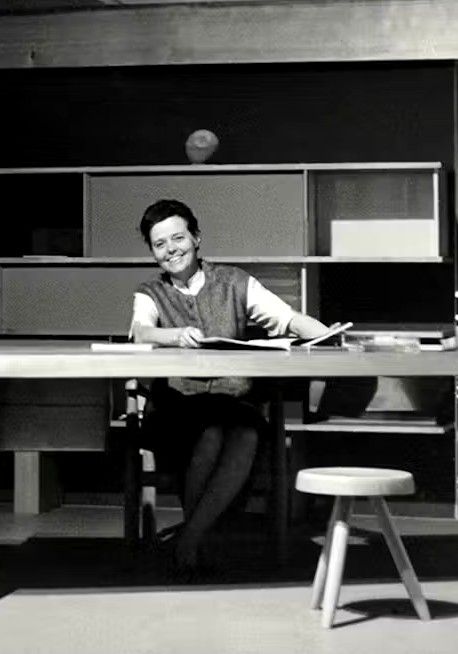
Charlotte Perriand at Work, Tokyo (1955)
Among other teachers, she studied under illustrator and designer Henri Rapin. Graduating in 1925, she continued learning through design workshops given at department stores and attending lectures by 'La Maîtrise' studio director Maurice Dufrêne.
Dufrêne was apparently so impressed with her work that he displayed some of her wall-hanging designs at the Galeries Lafayette department store in Paris. Two of her projects for the Decorative Arts school were selected for display at the 1925 Exposition Internationale des Arts Décoratifs et Industriels Modernes in Paris. They included the binding of an architectural book by Paul Valéry, Eupalinos ou l'architecte, and a wrought-iron gate.
Perriand married fabric merchant Percy Kilner Scholefield in 1926, moving with him into a former photographer's studio opposite the Saint-Sulpice church. Here, she renovated their apartment including the attic, which she turned into a room with a built-in wall bar using aluminum, glass and chrome. She recreated the Saint-Sulpice attic room at the 1927 Paris Salon d'Automne, calling Bar sous le Toit ('Bar 'in the attic' - See the image below left.) This was "[a] reaction to what she saw as the overly fussy, decorative and predominantly wooden designs of her peers". ("The art of living: 10 things to know about Charlotte Perriand", Christie's website, gathered 10-24-24) Perriand also exhibited a cabinet of violet wood, glass and metal decorated in gold pieces at the Salon des Artistes Décoratifs in 1927.
A friend had given Perriand two books written by architect and designer Charles-Édouard Jeanneret (Le Corbusier): Vers une architecture and L'Art décoratif d'aujourd'hui. They so impacted her that she applied to work at his atelier. Meeting with Le Corbusier and showing him her portfolio, she was told, "We don't embroider cushions here." Even though she was rejected, she told him about her display at the Salon d'Automn, which he and his cousin Pierre Jeanneret visited the next day. When Jeanneret saw the Bar sous le Toit at the Salon, he decided to offer her an unpaid position as an 'associate for the interior design of houses'.
Perriand was also responsible for the interior design of
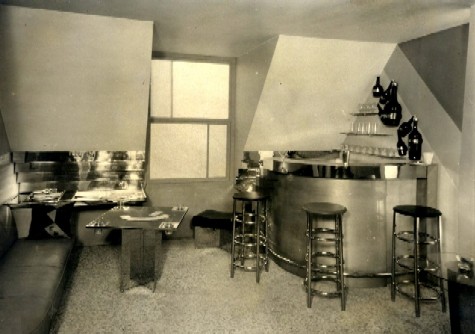
Attic Bar, Salon d'Automne, 1927, Inside Inside
the rooms Le Corbusier created. This would have been true on his various projects during her 10 year tenure with the atelier including the Villa Savoye (1928-31), the Salvation Army's Cité de Refuge (1930-3), the Swiss Pavilion at the Cité Internationale Universitaire de Paris (1930), his unrealized utopian design for the Villa Radieuse ('Radiant City', 1930) and the Centrosoyuz building in Moscow (1928-35), among others. For the 1935 Universal Exhibition in Brussels she designed the interiors for La Maison du Jeune Homme (Home of a young Man). It was designed with Le Corbusier, Pierre Jeanneret and René Herbst to be the living space of a young, sporty and cultured man. Among the group, "her impact reached far beyond furniture; Perriand brought to life the trio's [Perriand, Pierre and Eduoard] vision of modern luxury as Equipment for the Home for the 1929 Salon d'Automne, which included an entire apartment set with a bold kitchen and bathroom." ("Women in Architecture: Charlotte Perriand", Optima website, gathered 10-24-24)
In addition to interior design, she was responsible for designing furnishings and furniture as well as for promoting the designs through exhibitions. She worked closely with Jeanneret's cousin Pierre. Building upon Le Corbusier's functionalist declaration that a chair was 'a machine for sitting in', she designed three chairs in 1928 which are often mentioned as examples of her work for the company. The three types of chairs included one for one for sleeping - the B306 chaise longue, one for relaxing - the LC2 Grand Confort, and sitting - the B301 sling back. They were introduced at the 1929 Salon d'Autumne. (See the images below.)
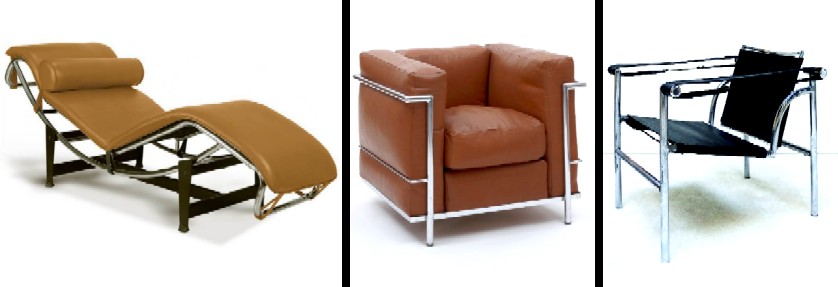 Perriand's Chairs, from left - Chaise Lounge Basculante B306, Top Grain-Tan, Chromed and Painted Metal Reproduction, 1928-9; LC2 Confort Chair,
Perriand's Chairs, from left - Chaise Lounge Basculante B306, Top Grain-Tan, Chromed and Painted Metal Reproduction, 1928-9; LC2 Confort Chair,Chromed Steel, Horsehari, Leather, 1959, Museum of Modern Art; B301 Sling Back Chair, 1929, Jousse-Enterprise
Working for Le Corbusier was challenging. Some time after Perriand divorced Scholefield (1932), Le Corubusier asked her, "You prefer women, perhaps?" "This question had shocked Perriand and, according to Nicholas Fox Weber, Le Corbusier's biographer, something was then definitively broken between her and the architect. 'She deeply admired Le Corbusier,' confirms Pernette. 'And she always defended his work. But the man was a different story! For her, working with him was a burden.'" (Thijs Demeulemeester, "Exposition Charlotte Periand", ufvab.be, gathered 10-24-24) Even the environment was challenging at times. "It was a spartan, financially precarious environment, and she had to wrap her legs in newspaper to stave off the cold while she worked." ("10 things", Christie's) She finally left the atelier in 1937 to work on her career independently.
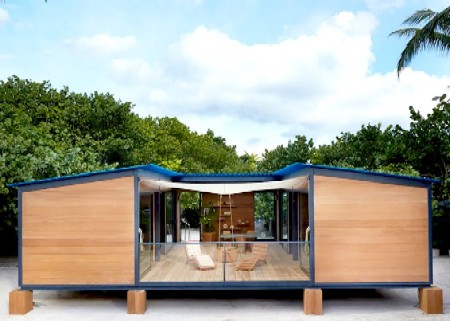
The House by the Water Built From Plans by Perriand from 1934, Sense Atlas
She later said, "I think the reason Le Corbusier took me on was because he thought I could carry through ideas. I was familiar with current technology, I knew how to use it and, what is more, I had ideas about the uses it could be put to." (Oliver Wainwright, "Charlotte Perriand: the design visionary who survived Le Corbusier's putdowns", The Guardian website, gathered 10-24-24)
During her tenure with Le Corbusier, Perriand had also worked on other projects during the interwar years. In 1929-1930, she designed a studio-bar for the private mansion of Jean and Joël Martel. She maintained close ties with the workshops of Jean Prouvé in Nancy, as well as with the architects Paul Nelson and the Lagneau-Weill-Dimitrijevic. In 1934, the magazine L'Architecture d'aujourd'huis sponsored a competition for the design of leisure homes for the working-class. Perriand created plans for the Maison au bord de l'eau (house by the water) for the contest which won second place. It was minimalist and modular, using prefabricated elements with a garage section under the house. Although it was was never built during her lifetime, the original plans were used to construct it in 2014. (See the image at right). This design showed how much she had learned about architecture working with Le Corbusier, becoming an architect in her own right.
Towards the end of the 1920s, Perriand became involved with socialist politics. She was one of the founders of the Union of Modern Artists along with Robert Mallet-Stevens, Eileen Gray and Jean Prouvé. They wanted to make art accessible to the working man leading to some of the designs she was involved with in the 1930s including the Salvation Army projects
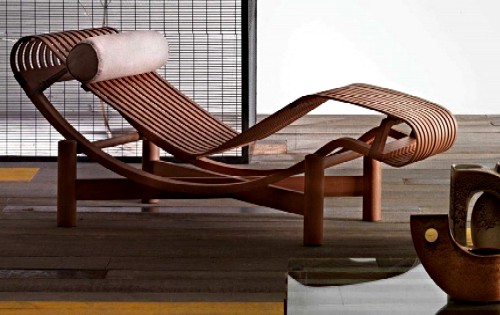
Tokyo Chaise Longue, Bamboo with Brass Studs, Designed in 1940, Modern, Matisse
and her entry in the L'Architecture d'aujourd'huis contest. For the 1936 Salon des arts ménages she created a photo montage which highlighted workers' demands and denouncing unhealthy lifestyles.
After leaving Le Corbusier's atelier, Perriand worked with Jean Prouvé designing military barracks and prefabricated temporary housing for the war effort. In 1940, she was invited to come to Japan where she became an industrial art advisor to the Ministry of Commerce and Industry. While there she studied bamboo, reporting on it's use in design, noting bamboo's flexibility and solidness deciding to create modern furniture from it using ancient techniques. One of her designs from this period was the Tokyo Chaise Longue, similar in many ways to her B306 Chaise Longue designed for Le Corbusier, but made almost entirely from bamboo. (See the image at left.) She found a receptive audience for her ideas in Japan, giving lectures the decorative arts. Because of the war, she left in 1942 for Indochina, but returned in 1953 and stayed for two more years.
She was repatriated to France in 1946, arriving to find her designs in demand. She worked on a variety of projects including several ski resorts, the interiors and kitchens for the Unité d'habitation, Air France's offices in Paris,
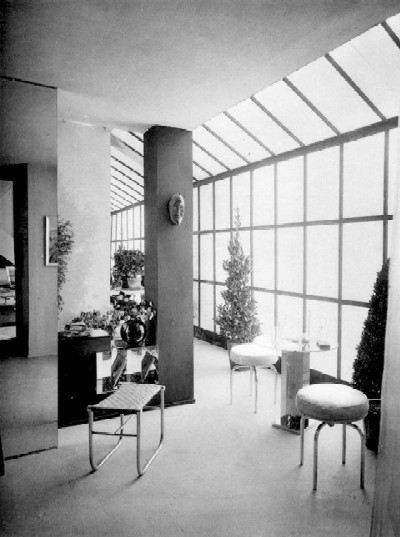
Dining Room, Salon des Artistes Décorateurs Rooms, 1926, Interieurs,
Plate 29, RIBA Collection
Tokyo and London and student housing among several other projects. Although she rarely chose to work on other architects' designs, she was eager to work with Jean Prouvé, who collaborated with her on several designs between 1951 and 1953 as well as upon her return from Japan in 1955. The ski resorts at Les Arcs in Savoie, built between 1967 and 1982, are considered by some to be the apex of her architectural career.
"There was a profoundly human element to Perriand's work. She believed that good design should be affordable and functional, and she blurred the lines between the mechanical indoor world and the organic outdoor one (she would go beachcombing on the shores of Normandy for inspiration, photographing sea-smoothed lumps of driftwood and rock)." (Christie's website)
Many of the images here are those Perriand helped design while working with Pierre and Charles-Édouard Jeanneret. Charles-Édouard's involvement is likely minimal, other than as an inspirational source. (He referred to details such as furniture in a room as "le blah blah blah".) Given that the style of the furniture is in line with her independently developed 'Bar sous le Toit', the designs are almost certainly hers. Many of the furniture pieces seen below are reproductions from the original designs because the original furniture has not survived.
Sources Not Cited Above:
"Charlotte Perriand", American Wikipedia, gathered 10-24-24
"Le Corbusier", French Wikipedia, , gathered 10-24-24
"Charlotte Perriand", Context Gallery website, gathered 10-24-24
"Charlotte Perriand (1903-1999)", DWR website, gathered 10-24-24
"Make yourself at home with the works of Charlotte Perriand at Foundation Louis Vuitton", Wallpaper.com Website, gathered 10-24-24
J. J. Acuna, "The W+ Architecture: Villa Savoye/Poissy", Wanderlister.com, gathered 10-24-24
Arthur Ruegg, "The Clarte building in the creations of le Corbusier and Pierre Jenneret", Issuu.com, gathered 10-24-24
"CV-Pierre-Jeanneret", Galerie Patrick Seguin website, gathered 10-24-24
Carole Aragon, "La Maison au Bord de l'Eau, a Project for the Right to Leisure", Senses Atlas website, gathered 10-24-24
Original Facebook Group Profile